As the party was on Easter Sunday, we spent Monday tidying up and putting things away – I was really glad I had hung on to a lot of my large entertaining dishes and had not got rid of them in a fit of decluttering earlier this year when I was reviewing all the little used items in my cupboards. I had taken an inexpensive ice bucket to the charity shop for that very reason; I didn’t think I would be hosting any more big summer parties now until maybe our 70th comes along and by then I reckon I could buy another cheap one if necessary. Well a lesson learned I really needed it last weekend.
By Tuesday I slumped into exhaustion and felt so lethargic I had to drag myself to Yoga class. I was pleasantly surprised that it actually boosted my energy levels considerably and afterwards we decided it was time to get out of the house for a while and just go for a wander somewhere – so we packed up, jumped in the car and went out with a picnic.
We were headed for Derbyshire – our usual route over the Strines but at the last-minute decided to go up over by Holme Moss across the valley from us. We stopped in the little car park beside the mast and admired the view below while we ate. It was a very hazy day but the view from here is glorious and looks out over the tiny village of Holme to the left of the reservoir – you can just about see almost centre of the photo, and to the right and behind the reservoir you can just make out the market town of Holmfirth (Last of the Summer Wine fame) – our village is nestled in the valley just beyond the hills on the left. If you do not know the Pennine area then this is how high you have to climb to be able to see over a hill around here.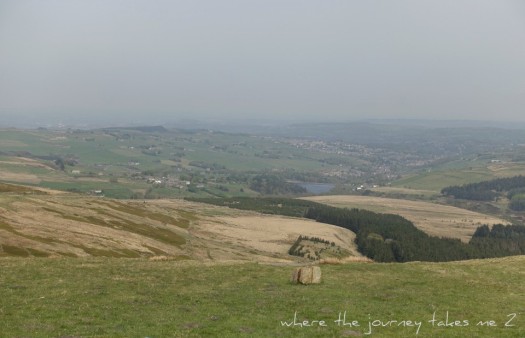
 We drove down the steep winding road from Holme Moss to meet the notorious Snake Pass and then along the valley bottom and over to Glossop, a small old mill town in the High Peak enjoying a bit of a revival, where we stopped and rang an old college friend of mine who lives close by on the off-chance they might be at home. She and her new partner came to meet us and we enjoyed a lovely relaxing afternoon with them in a local cafe chatting and catching up.
We drove down the steep winding road from Holme Moss to meet the notorious Snake Pass and then along the valley bottom and over to Glossop, a small old mill town in the High Peak enjoying a bit of a revival, where we stopped and rang an old college friend of mine who lives close by on the off-chance they might be at home. She and her new partner came to meet us and we enjoyed a lovely relaxing afternoon with them in a local cafe chatting and catching up.
When they went home we had a wander around Glossop town centre – I was amazed at some of the lovely old buildings and the fascinating and rich history of the town. We will be going back to visit again soon and next time we will walk up to Old Glossop which is the original village and has some delightful old cottages clustered around the church.
We began our walk down the main street – this was the first indication we had seen all day that it was St George’s day.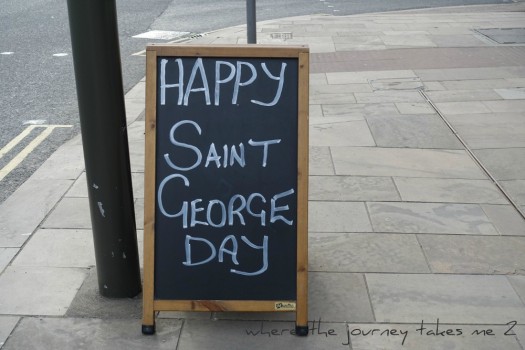 Venturing up one or two of the side streets we came across this fine old building – the Glossop Gas Works which is now home to a few new business enterprises. Before Gas became available the mills like everywhere else would have been lit by candlelight through necessity to work 24 hours a day. This was expensive and so the textile mills were one of the first places that were used to develop this new technology and demonstrate it to a very sceptical public.
Venturing up one or two of the side streets we came across this fine old building – the Glossop Gas Works which is now home to a few new business enterprises. Before Gas became available the mills like everywhere else would have been lit by candlelight through necessity to work 24 hours a day. This was expensive and so the textile mills were one of the first places that were used to develop this new technology and demonstrate it to a very sceptical public. 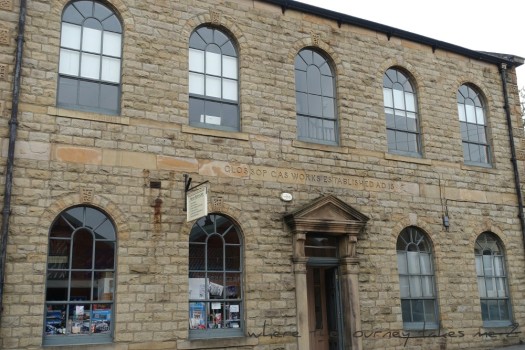 We crossed the road and began our walk back, once again exploring a few of the side streets as something caught our eye, and discovered this unusual church building – The Central Methodist Church.
We crossed the road and began our walk back, once again exploring a few of the side streets as something caught our eye, and discovered this unusual church building – The Central Methodist Church.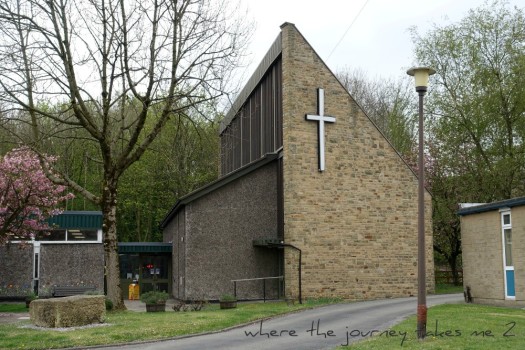
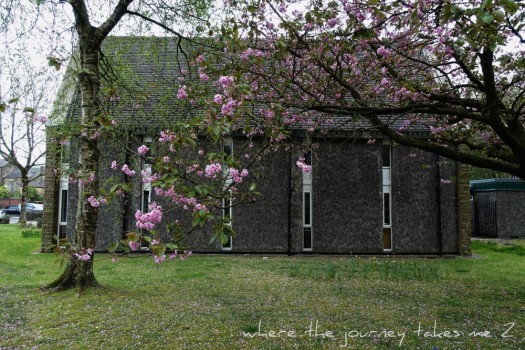 I tried to get a photo of the light flooding the inside of the chapel through the windows around the back. Perhaps on another visit we might be able to go inside.
I tried to get a photo of the light flooding the inside of the chapel through the windows around the back. Perhaps on another visit we might be able to go inside.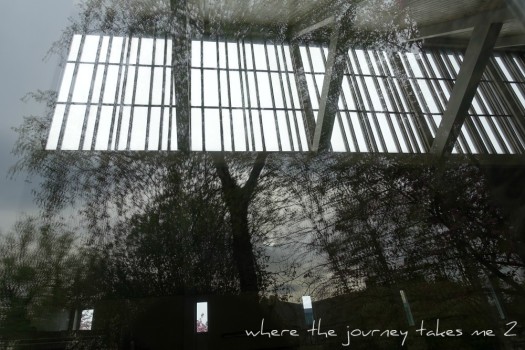 On the corner of High Street West and George Street we came across the Oakwood. This site has a long and chequered history since 1844 when originally it was an inn owned by George Pye and remained in his family till 1875 when it was sold and demolished to make way for a very grand hotel complete with balcony and flagpoles at a cost of £6,000. In fact there are many balconied buildings around Glossop.
On the corner of High Street West and George Street we came across the Oakwood. This site has a long and chequered history since 1844 when originally it was an inn owned by George Pye and remained in his family till 1875 when it was sold and demolished to make way for a very grand hotel complete with balcony and flagpoles at a cost of £6,000. In fact there are many balconied buildings around Glossop.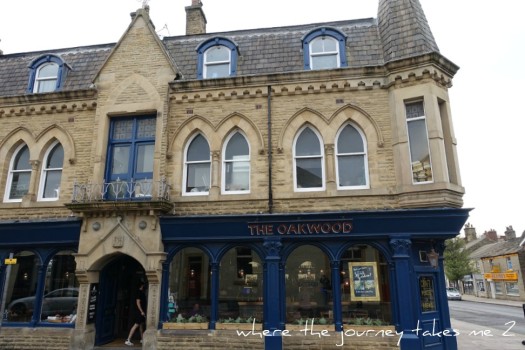 During its time the spire has been removed and in 1901 it was bought by Robinson’s Brewery and had a major renovation in 1991. Today it is still with the brewery and is a popular place to eat and drink.
During its time the spire has been removed and in 1901 it was bought by Robinson’s Brewery and had a major renovation in 1991. Today it is still with the brewery and is a popular place to eat and drink.
Glossop would have grown in size very quickly as the mills were built so the streets are lined with rows of terraced housing and here and there are dotted a few lovely little independent shops.
 It struck me that the streets here are unusually wide compared with a lot of mill towns – hence the name dark satanic mills because the mills were tall and the streets narrow and claustrophobic. Here it felt much lighter.
It struck me that the streets here are unusually wide compared with a lot of mill towns – hence the name dark satanic mills because the mills were tall and the streets narrow and claustrophobic. Here it felt much lighter.
In a mill town you are never very far away from a stream or river as the water was used to power the machinery for the different processes in the mills. It was vital that the area had a heavy annual rainfall to feed these streams and Glossop fit the bill with over 60 inches a year on the surrounding hills.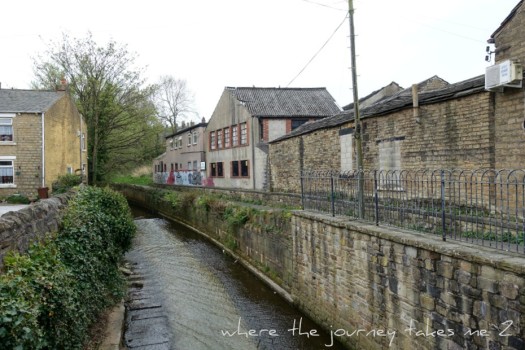 The mills around Glossop mainly produced cotton, as more mills were built more people had to be ‘imported’ in to the area and the town grew in size – a town hall with adjacent market hall and shopping arcade, now one of the popular attractions here, was built in 1938 by 12th Duke of Norfolk at a cost of £8,500 – not quite as glamorous as the shopping arcade in the centre of Leeds but none the less it has some handsome architectural merit and is currently undergoing extensive renovations and covered in scaffolding and sheeting so I wasn’t able to take a picture of the front of this grand domed building but here is a peek inside.
The mills around Glossop mainly produced cotton, as more mills were built more people had to be ‘imported’ in to the area and the town grew in size – a town hall with adjacent market hall and shopping arcade, now one of the popular attractions here, was built in 1938 by 12th Duke of Norfolk at a cost of £8,500 – not quite as glamorous as the shopping arcade in the centre of Leeds but none the less it has some handsome architectural merit and is currently undergoing extensive renovations and covered in scaffolding and sheeting so I wasn’t able to take a picture of the front of this grand domed building but here is a peek inside.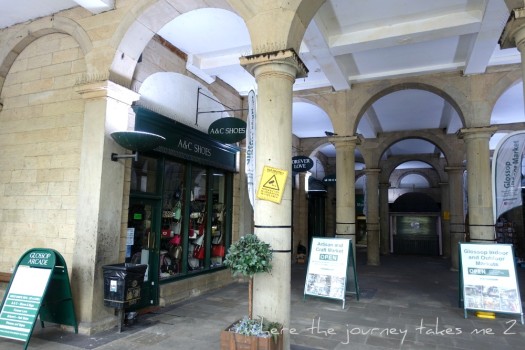

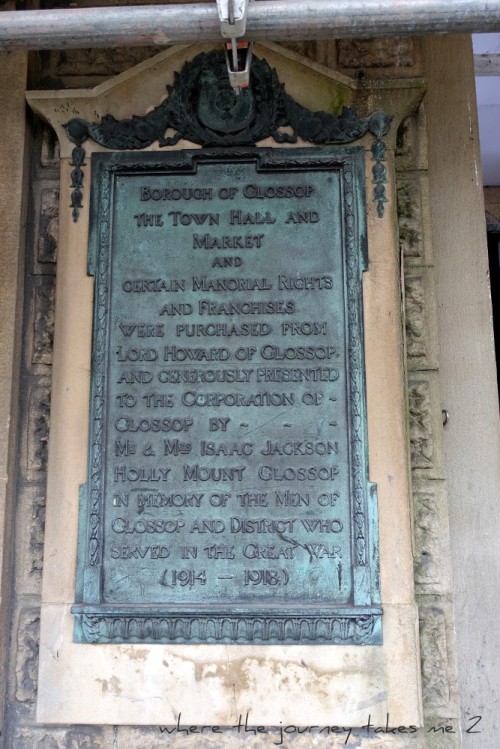 Opposite the Market Hall is the town square – so very well kept with borders running along each side that are a riot of colour and a credit to the Council.
Opposite the Market Hall is the town square – so very well kept with borders running along each side that are a riot of colour and a credit to the Council.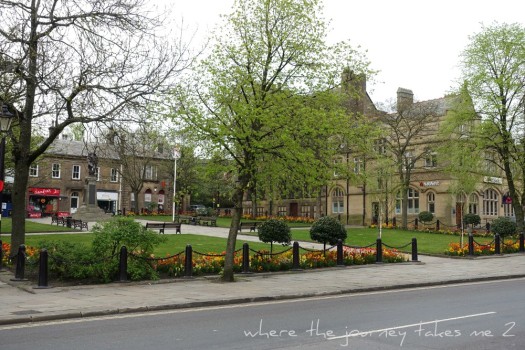 In the centre of the square is a war memorial with a statue of an angel gracefully holding a laurel wreath – it is quite beautiful and a fitting tribute to the many men of the town who gave their lives in the war.
In the centre of the square is a war memorial with a statue of an angel gracefully holding a laurel wreath – it is quite beautiful and a fitting tribute to the many men of the town who gave their lives in the war.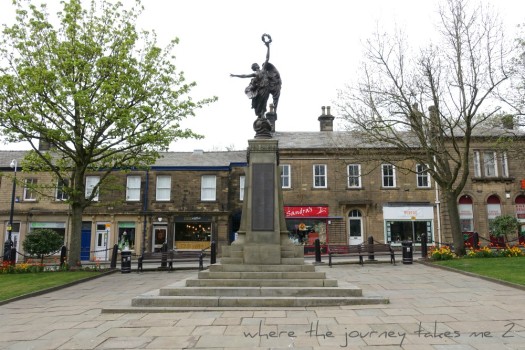 There were some very wealthy mill owners in the area which generated rather a lot of rivalry between them. This in turn benefitted the local people as each of the mill owners built public buildings such as the public baths, parks and libraries for their workforces. Mrs Wood, wife of John Wood donated four drinking fountains to the town of which I believe this could be one of them.
There were some very wealthy mill owners in the area which generated rather a lot of rivalry between them. This in turn benefitted the local people as each of the mill owners built public buildings such as the public baths, parks and libraries for their workforces. Mrs Wood, wife of John Wood donated four drinking fountains to the town of which I believe this could be one of them. 
 Edward Partington owned one of the paper mills and as he was a Liberal laid the foundation stone of the Liberal club. He also built the library and a convalescent home.
Edward Partington owned one of the paper mills and as he was a Liberal laid the foundation stone of the Liberal club. He also built the library and a convalescent home.  The former Liberal club I think is one of the finest buildings on the square with yet another small balcony – it was turned into a small theatre in 1957 and became a new home for the Partington Players.
The former Liberal club I think is one of the finest buildings on the square with yet another small balcony – it was turned into a small theatre in 1957 and became a new home for the Partington Players.
 …..watched over by a statue of Hamlet…
…..watched over by a statue of Hamlet…
 Just off the back of the square past the Theatre is a rather grand flight of steps up to the station forecourt.
Just off the back of the square past the Theatre is a rather grand flight of steps up to the station forecourt. 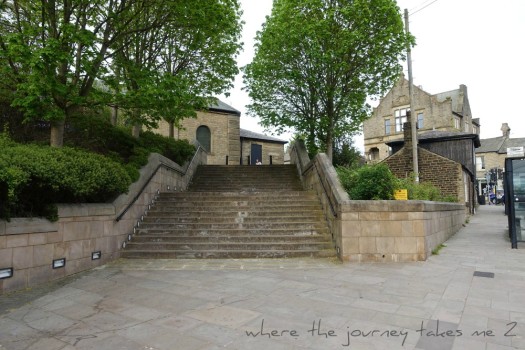 The mystery little cottage to the right of the photo above built into the slope has a cute little garden, now overgrown but with signs of herbs and vegetables being grown up to very recently. To one side it has a wooden first floor extension which from the other side resembles some kind of ticket office – but as yet I have no clues as to what it might have been use for.
The mystery little cottage to the right of the photo above built into the slope has a cute little garden, now overgrown but with signs of herbs and vegetables being grown up to very recently. To one side it has a wooden first floor extension which from the other side resembles some kind of ticket office – but as yet I have no clues as to what it might have been use for.  And this is where we finished our little stroll – I hope you enjoyed your visit to this lovely little mill town – sadly many of the mills have been demolished now but a few survive with a new lease of life as shopping centres and businesses. It was a hard life in a mill town, the mill owners were quite entrepreneurial people in their time as the industrial revolution took hold and they became very prosperous mainly due to the hard work of the people who toiled long hours day in and day out in these noisy, dust ridden buildings.
And this is where we finished our little stroll – I hope you enjoyed your visit to this lovely little mill town – sadly many of the mills have been demolished now but a few survive with a new lease of life as shopping centres and businesses. It was a hard life in a mill town, the mill owners were quite entrepreneurial people in their time as the industrial revolution took hold and they became very prosperous mainly due to the hard work of the people who toiled long hours day in and day out in these noisy, dust ridden buildings.
I remember when as a young girl we moved from Sheffield and the steel works to Huddersfield and the giant woollen mills the effect it had on me with the tall chimneys everywhere rearing up against the skyline – dark dreary Victorian stone buildings stained by the many years of soot. Like in Glossop not all have survived, some have disappeared others turned into anything from student accommodation to shopping outlets but the heritage of these places live on.
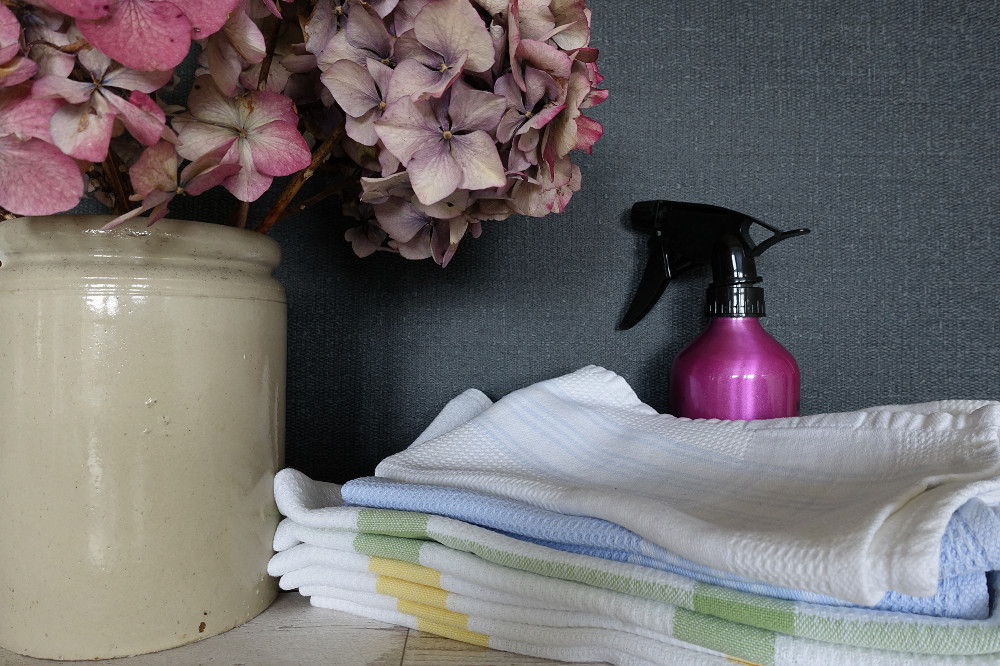


 At first glance it wasn’t obvious that the church was still in use but further investigation told me it probably was (and of course Google helped later). It is a listed church dedicated to St Marjory and built in 1793 on the site of the initial medieval church that was knocked down and of which there are no remains.
At first glance it wasn’t obvious that the church was still in use but further investigation told me it probably was (and of course Google helped later). It is a listed church dedicated to St Marjory and built in 1793 on the site of the initial medieval church that was knocked down and of which there are no remains. One of the things that struck me wandering around the graveyard is firstly that it is such a wild yet beautiful graveyard, so peaceful with a view that stretches over to the Solway estuary in the background. The second thing is the sheer size of all these 18th Century grave stones that are packed into this graveyard and almost towered above me and more resembled one of those large city cemeteries than a tiny parish church. All around the graves the grass was long underfoot and difficult to walk over with mounds and clumps entwined with brambles.
One of the things that struck me wandering around the graveyard is firstly that it is such a wild yet beautiful graveyard, so peaceful with a view that stretches over to the Solway estuary in the background. The second thing is the sheer size of all these 18th Century grave stones that are packed into this graveyard and almost towered above me and more resembled one of those large city cemeteries than a tiny parish church. All around the graves the grass was long underfoot and difficult to walk over with mounds and clumps entwined with brambles.
 These two graves I came across are a sad reminder of how children often died young through infectious diseases that couldn’t be cured back then and how some families lost more than one child at the same time with the same illness. This was written on the gravestones…
These two graves I came across are a sad reminder of how children often died young through infectious diseases that couldn’t be cured back then and how some families lost more than one child at the same time with the same illness. This was written on the gravestones… What a truly peaceful place to sit and ponder on life…
What a truly peaceful place to sit and ponder on life… I love that row of stars strung across the main street. Tomorrow we are going into Stranraer to watch the Christmas parade and switching on of the lights in the town centre and see these Three Wise Men on their camels. Can’t wait.
I love that row of stars strung across the main street. Tomorrow we are going into Stranraer to watch the Christmas parade and switching on of the lights in the town centre and see these Three Wise Men on their camels. Can’t wait.













